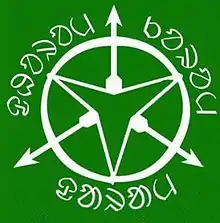Sarna sthal
Sarna sthals are sacred groves in the religious traditions of the Chota Nagpur Plateau region in the states of Jharkhand, Bihar, Assam and Chhattisgarh. Followers of these rituals primarily belong to the Baiga, Oraon, Ho,[1] Kurukh, Munda and Santal. According to local belief, a Gram deoti or village deity resides in the sarna, where sacrifice is offered twice a year. In recent years many tribal and Kudumi Mahato organization have demanded a religious code for Sarna, separate from Hinduism, as they believe that they are nature worshippers.
Etymology
Sarna means "grove" and is etymologically related to the name of the sal tree. For Santali mythological belief 'Sarna' means 'it is arrow'[Sar- arrow, Na- it is (in feminine gender of Santali grammar)
Theology
Adherents of Sarnaism believe in, worship, and revere a village deity as protector of village, who is called as Gaon khunt, Gram deoti, Dharmes, Marang Buru, Singbonga, or by other names by different tribes.[2] Adherents also believe in, worship, and revere Dharti ayo or Chalapachho Devi, the mother goddess identified as the earth or nature.
Worship places and rites

Sarna is place of worship which is sacred grove. It is also called gram than, Jaher than or Jaher gar, and can be found in villages. Sal trees are in the sacred grove. The ceremonies are performed by the whole village community at a public gathering with the active participation of village priests, pahan. The chief assistant of village priest is called Naike.
The sthal typically has multiple trees like sal, mahua, neem, and banyan.
The main festival of Sarnaism is Sarhul, a festival in which devotees worship their ancestors. A legend among the Munda says a lion once ran after a man, who escaped by hiding in a bush. After the incident, he promised he would offer sakua flowers and leaves as well as a living animal. During the festival, the pahan brings three water pots to the sarna. If the water pots reduce in level, they believe the monsoon will fail, but if it stays the same the monsoon will come as normal. Men then offer sakua flowers and leaves.[3]
Demographics
Overall population: c. 4,957,000[4]
- Jharkhand: 4,223,500
- Bihar: 1,349,460
- Odisha: 500,000 to 1,000,000 (estimated)
- Assam: 1,000,000 to 1,200,000 (estimated)
- Chhattisgarh: 768,910 (estimated)
Demand for a Sarna census code
Several organisations of tribal and Kudumi Mahato are demanding a distinct census code for the Sarna religion.[5][6][7]
Recently Jharkhand assembly unanimously passed a resolution on 'Sarna Code' for the inclusion of Sarna as separate religion in 2021 census, and sent to central government for approval.[8]
Organisations

- Akhil Bharatiya Sarna Dharam (ABSD)
- All India Sarna Dharam Mandowa (AISDM)
- Kherwal Saonta Semled (KSS)
See also
References
- "कुड़मी जनप्रतिनिधियों का होगा बहिष्कार : लाल्टू". bhaskar. 23 July 2018. Retrieved 10 November 2019.
- Amit Jha (2009). Contemporary Religious Institutions in Tribal India. ISBN 9780557090532.
- Srivastava, Malini (1 October 2007). "The Sacred Complex of Munda Tribe". The Anthropologist. 9 (4): 327–330. doi:10.1080/09720073.2007.11891020. ISSN 0972-0073. S2CID 73737689.
- Shaikh, Zeeshan. "Fewer minor faiths in India now, finds Census; number of their adherents up". The Indian Express.
- Kiro, Santosh K. (2013). "Delhi demo for Sarna identity". The Telegraph.
- Mukherjee, Pranab (30 March 2013). "Tribals to rally for inclusion of Sarna religion in census". Times of India.
- "मांगे नहीं मानी तो जारी रहेगा आंदोलन". jagran.com. Retrieved 10 November 2019.
- "Jharkhand Assembly passes resolution on Sarna Code". The Hindu. 12 November 2020.
Bibliography
Books
- Sachchidananda, A.K. (1980). Elite and Development. New Delhi: Concept Publishing Co. ASIN B000MBN8J2.
- Minahan, James (2012). Ethnic Groups of South Asia and the Pacific: An encyclopedia. Ethnic Groups of the World. ABC-CLIO. ISBN 978-1598846591.
- Niketan, Kishor Vidya (1988). The Spectrum of Tribal Religion in Bihar: A study of continuity & change among the Oraon of Chotanagpur.
- Hembram, Phatik Chandra (1988). Sari-Sarna (Santhal religion). Mittal Publications. ISBN 8170990440.
Journal articles
- Srivastava, Malini (2007). "The Sacred Complex of Munda Tribe" (PDF). Anthropologist. 9 (4): 327–330. doi:10.1080/09720073.2007.11891020. S2CID 73737689.
External links
- "Adivasi Religion and Society Network". arsnetwork.org.
